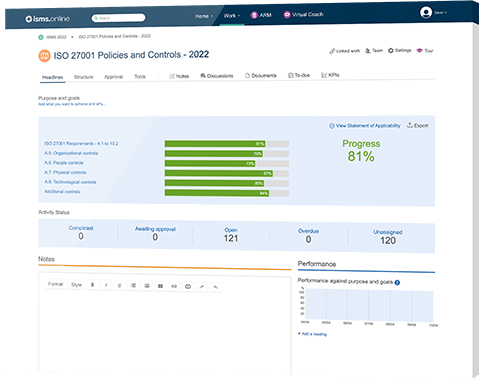
Control 5.19 concerns itself with an organisation’s obligation to ensure that, when using supplier-side products and services (including cloud service providers), adequate consideration is given to the level of risk inherent in using external systems, and the consequential impact that may have on their own information security adherence.
5.19 is a preventative control that modifies risk by maintaining procedures that address inherent security risks associated with the use of products and services provided by third parties.
Whereas Control 5.20 deals with information security within supplier agreements, Control 5.19 is broadly concerned with adherence throughout the course of the relationship.
| Control Type | Information Security Properties | Cybersecurity Concepts | Operational Capabilities | Security Domains |
|---|---|---|---|---|
| #Preventative | #Confidentiality #Integrity #Availability | #Identify | #Supplier Relationships Security | #Governance and Ecosystem #Protection |
We started off using spreadsheets and it was a nightmare. With the ISMS.online solution, all the hard work was made easy.
Whilst Control 5.19 contains a lot of guidance on the use of ICT services, the broader scope of the control encompasses many other aspects of an organisation’s relationship with its supplier base, including supplier types, logistics, utilities, financial services and infrastructure components).
As such, ownership of Control 5.19 should rest with a member of senior management that oversees an organisation’s commercial operation, and maintains a direct relationship with an organisation’s suppliers, such as a Chief Operating Officer.
Compliance with Control 5.19 involves adhering to what’s known as a ‘topic-specific’ approach to information security in supplier relationships.
Topic-specific approaches encourage organisations to create supplier-related policies that are tailored towards individual business functions, rather than adhering to a blanket supplier management policy that applies to any and all third party relationships across an organisation’s commercial operation.
It’s important to note that Control 5.19 asks the organisation to implement policies and procedures that not only govern the organisation’s use of supplier resources and cloud platforms, but also form the basis of how they expect their suppliers to conduct themselves prior to and throughout the term of the commercial relationship.
As such, Control 5.19 can be viewed as the essential qualifying document that dictates how information security governance is handled over the course of a supplier contract.
Control 5.19 contains 14 main guidance points to be adhered to:
1) Maintain an accurate record of supplier types (e.g. financial services, ICT hardware, telephony) that have the potential to affect information security integrity.
Compliance – Draft a list of any and all suppliers that your organisation works with, categorise them according to their business function and add categories to said supplier types as and when required.
2) Understand how to vet suppliers, based on the level of risk inherent for their supplier type.
Compliance – Different supplier types will require different due diligence checks. Consider using vetting methods on a supplier-by-supplier basis (e.g. industry references, financial statements, onsite assessments, sector-specific certifications such as Microsoft Partnerships).
3) Identify suppliers that have pre-existing information security controls in place.
Compliance – Ask to see copies of suppliers’ relevant information security governance procedures, in order to evaluate the risk to your own organisation. If they don’t have any, it’s not a good sign.
4) Identify and define the specific areas of your organisation’s ICT infrastructure that your suppliers will be able to either access, monitor or make use of themselves.
Compliance – It’s important to establish from the outset precisely how your suppliers are going to interact with your ICT assets – be they physical or virtual – and what levels of access they’re granted in accordance with their contractual obligations.
5) Define how the suppliers’ own ICT infrastructure can impact upon your own data, and that of your customers.
Compliance – An organisation’s first obligation is to its own set of information security standards. Supplier ICT assets need to be reviewed in accordance with their potential to affect uptime and integrity throughout your organisation.
6) Identify and manage the various information security risks attached to:
a. Supplier use of confidential information or protected assets (e.g. limited to malicious use and/or criminal intent).
b. Faulty supplier hardware or malfunctioning software platform associated with on-premise or cloud based services.
Compliance – Organisations need to be continually mindful of the information security risks associated with catastrophic events, such as nefarious supplier-side user activity or major unforeseen software incidents, and their impact on organisational information security.

We’ll give you an 81% headstart
from the moment you log in
Book your demo
7) Monitor information security compliance on a topic specific or supplier type basis.
Compliance – Organisation’s need to appreciate the information security implications inherent within each supplier type, and adjust their monitoring activity to accommodate varying levels of risk.
8) Limit the amount of damage and/or disruption caused through non-compliance.
Compliance – Supplier activity should be monitored in an appropriate manner, and to varying degrees, in accordance with its risk level. Where non-compliance is discovered, either proactively or reactively, immediate action should be taken.
9) Maintain a robust incident management procedure that addresses a reasonable amount of contingencies.
Compliance – Organisations should understand precisely how to react when faced with a broad range of events relating to the supply of third party products and services, and outline remedial actions that include both the supplier and the organisation.
10) Enact measures that cater to the availability and processing of the supplier’s information, wherever it’s used, thereby ensuring the integrity of the organisation’s own information.
Compliance – Steps should be taken to ensure that supplier systems and data are handled in a way that doesn’t compromise on the availability and security of the organisation’s own systems and information.
11) Draft a thorough training plan that offers guidance on how staff should interact with supplier personnel and information on a supplier-by-supplier basis, or on a type-by-type basis.
Compliance – Training should cover the full spectrum of governance between an organisation and its suppliers, including engagement, granular risk management controls and topic-specific procedures.
12) Understand and manage the level of risk inherent when transferring information and physical and virtual assets between the organisation and their suppliers.
Compliance – Organisations should map out each stage of the transfer process and educate staff as to the risks associated with moving assets and information from one source to another.
13) Ensure that supplier relationships are terminated with information security in mind, including removing access rights and the ability to access organisational information.
Compliance – Your ICT teams should have a clear understanding of how to revoke a supplier’s access to information, including:
14) Outline precisely how you expect the supplier to conduct themselves regarding physical and virtual security measures.
Compliance – Organisations should set clear expectations from the outset of any commercial relationship, that specify how supplier-side personnel are expected to conduct themselves when interacting with your staff or any relevant assets.
ISO acknowledges that it’s not always possible to impose a full set of policies on a supplier that meet each and every requirement from the above list as Control 5.19 intends, especially when dealing with rigid public sector organisations.
That being said, Control 5.19 clearly states that organisations should use the above guidance when forming relationships with suppliers, and consider non-adherence on a case-by-case basis.
Where full compliance isn’t achievable, Control 5.19 gives organisations leeway by recommending “compensating controls” that achieve adequate levels of risk management, based on an organisation’s unique circumstances.
27002:2022-5.19 replaces 27002:2013-5.1.1 (Information security policy for supplier relationships).
27002:2022-5.19 broadly adheres to the same underlying concepts contained in the 2013 control, but does contain several additional guidance areas that are either omitted from 27002:2013-5.1.1, or at the very least not covered in as much detail, including:
27002:2022-5.19 is also explicit in acknowledging the highly variable nature of supplier relationships (based on type, sector and risk level), and gives organisations a certain degree of leeway when considering the possibility of non-compliance of any given guidance point, based on the nature of the relationship (see ‘Supplementary Guidance’ above).
Using ISMS.online you can:
It’s a simple matter of creating a free trial account and following the steps we provide.
Get in touch today to book a demo.
It helps drive our behaviour in a positive way that works for us
& our culture.
| ISO/IEC 27002:2022 Control Identifier | ISO/IEC 27002:2013 Control Identifier | Control Name |
|---|---|---|
| 5.7 | New | Threat intelligence |
| 5.23 | New | Information security for use of cloud services |
| 5.30 | New | ICT readiness for business continuity |
| 7.4 | New | Physical security monitoring |
| 8.9 | New | Configuration management |
| 8.10 | New | Information deletion |
| 8.11 | New | Data masking |
| 8.12 | New | Data leakage prevention |
| 8.16 | New | Monitoring activities |
| 8.23 | New | Web filtering |
| 8.28 | New | Secure coding |
| ISO/IEC 27002:2022 Control Identifier | ISO/IEC 27002:2013 Control Identifier | Control Name |
|---|---|---|
| 6.1 | 07.1.1 | Screening |
| 6.2 | 07.1.2 | Terms and conditions of employment |
| 6.3 | 07.2.2 | Information security awareness, education and training |
| 6.4 | 07.2.3 | Disciplinary process |
| 6.5 | 07.3.1 | Responsibilities after termination or change of employment |
| 6.6 | 13.2.4 | Confidentiality or non-disclosure agreements |
| 6.7 | 06.2.2 | Remote working |
| 6.8 | 16.1.2, 16.1.3 | Information security event reporting |
| ISO/IEC 27002:2022 Control Identifier | ISO/IEC 27002:2013 Control Identifier | Control Name |
|---|---|---|
| 7.1 | 11.1.1 | Physical security perimeters |
| 7.2 | 11.1.2, 11.1.6 | Physical entry |
| 7.3 | 11.1.3 | Securing offices, rooms and facilities |
| 7.4 | New | Physical security monitoring |
| 7.5 | 11.1.4 | Protecting against physical and environmental threats |
| 7.6 | 11.1.5 | Working in secure areas |
| 7.7 | 11.2.9 | Clear desk and clear screen |
| 7.8 | 11.2.1 | Equipment siting and protection |
| 7.9 | 11.2.6 | Security of assets off-premises |
| 7.10 | 08.3.1, 08.3.2, 08.3.3, 11.2.5 | Storage media |
| 7.11 | 11.2.2 | Supporting utilities |
| 7.12 | 11.2.3 | Cabling security |
| 7.13 | 11.2.4 | Equipment maintenance |
| 7.14 | 11.2.7 | Secure disposal or re-use of equipment |